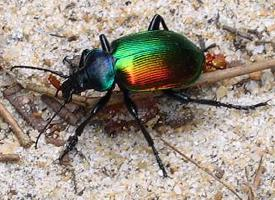
Popis zvířete
The Forest caterpillar hunter, scientifically known as Calosoma sycophanta, is a remarkable beetle that plays a significant role in forest ecosystems. This species belongs to the Carabidae family, which is known for its diverse and often brightly colored members. The Forest caterpillar hunter is no exception, with its vibrant and metallic appearance making it a visually striking creature.Adults of Calosoma sycophanta can reach sizes of 20 to 35 millimeters in length, showcasing a robust and somewhat elongated body structure. Their exoskeleton is hard and glossy, primarily adorned with metallic shades of green, blue, or sometimes even gold, which shimmer under sunlight. This iridescent quality not only makes them a beautiful sight but also serves as a deterrent to predators by creating a confusing visual effect.
One of the most notable features of the Forest caterpillar hunter is its incredible appetite for caterpillars. This beetle is a voracious predator, specializing in hunting down and consuming large numbers of caterpillars, including those of the gypsy moth and other species that are considered pests in forested areas. Its diet plays a crucial role in controlling the populations of these caterpillars, thereby protecting the trees and plants they would otherwise defoliate. The larvae of Calosoma sycophanta are equally predatory, actively seeking out prey soon after hatching.
The hunting strategy of the Forest caterpillar hunter is both efficient and relentless. Equipped with strong mandibles, it is capable of capturing and consuming a wide range of prey sizes. Adults are known to climb trees in search of their caterpillar prey, demonstrating a level of agility and determination that is quite remarkable for beetles.
The reproductive cycle of Calosoma sycophanta begins in spring when females lay eggs in the soil. The eggs hatch into larvae, which undergo several developmental stages before pupating and emerging as adults. This life cycle is closely linked to the availability of prey, ensuring that the next generation of beetles has ample food resources for growth and development.
Despite their beneficial role in controlling pest populations, Forest caterpillar hunters are also fascinating creatures in their own right. Their striking appearance, interesting behaviors, and ecological importance make them a valuable component of their natural habitats. Conservation efforts are essential to ensure that these beetles, along with the biodiversity of the forests they inhabit, are preserved for future generations to admire and study.
Nové fotografie zvířat
Top 10 zvířat
- Chinese water dragon (Physignathus cocincinus)
- Galápagos tortoise (Geochelone nigra complex)
- Dolphin gull (Leucophaeus scoresbii)
- Japanese macaque (Macaca fuscata)
- Colombian red howler (Alouatta seniculus)
- Sea urchins (Echinoidea)
- Moustached guenon (Cercopithecus cephus)
- Diana monkey (Cercopithecus diana)
- Common reed warbler (Acrocephalus scirpaceus)
- Common house mosquito (Culex pipiens)